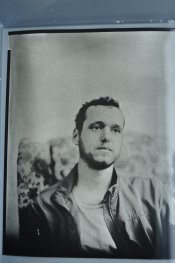Yesterday I decided to try out my "new" used Minolta IVf flash meter to see how it performed with my studio flashes and the Arista #2 paper. I mixed up fresh chemistry for both the hydrogen peroxide/citric acid bleach and potassium dichromate/sulfuric acid bleach.
For each exposure setting, I took two identically exposed shots with exactly the same flash settings. As there was very dim ambient light, I simply opened the shutter, popped the flash manually, and closed the shutter.
I tried metering at ISO 1.5, adding 3/4 stop for the bellows extension factor on my 210mm lens. This resulted in consistently overexposed images. Metering at ISO 3 (incident reading) resulted in a very good exposure after adding in the bellows factor.
The developer was Dektol mixed 1+1. The peroxide bleach was mixed 175mL water + 125mL 35% hydrogen peroxide + 2 level teaspoons citric acid (8.2 grams).
The second exposure was about 60 seconds under a 60-watt equivalent daylight-balanced flood lamp. I exposed the front and back of each print with constant motion to avoid hot spots.
The subject is an old Princess phone I grabbed off the shelf as a test subject. All scans are in color. I adjusted the gamma to neutral with full dynamic range in the scan, but otherwise the images are not retouched.
Here is my first test. The first image is with dichromate, the second with peroxide. Otherwise, identical processing was used. Both images are very overexposed, but I did note that the peroxide bleach almost instantly bleached the image white. The dark mottling showed up during the second development.
Second test shots. The dichromate process was routine. Exposure seems good. This time I noticed intense fizzing from the peroxide bleach, with an almost instant bleaching to white. The darkness and blotchiness in the peroxide print on the right showed up only during the second development.
The third set of test prints. I mixed fresh peroxide bleach for this test. These are overexposed again due to some lighting adjustments. The weird spots on the peroxide-bleached print showed up in the second development.
The final test prints. This is the best exposure in the batch. The dichromate-bleached print has a few spots, but looks good. The peroxide bleach is, well, .....
These tests were side-by-side with identical chemistries except for the bleach. The uneven bleaching is a real mystery. The clearer areas of the peroxide-bleached prints bleached almost immediately, but the darker patches took many minutes to lighten and never really bleached to complete white. The overexposed first print did bleach completely from a near-black first development. However, the second development revealed the dark splotches.
At this point, I am at a loss to explain what is happening as there seems to be no repeatability with the peroxide process. The potassium dichromate bleach works so well and gives such repeatable results, I think I will stick to that chemistry and abandon the peroxide. The dichromate bleach requires care in preparation and handling. It lasts for many, many prints, is inexpensive, and can be rendered relatively inert by adding sodium sulfite until it turns a deep green from orange.
I think the best explanation for what is happening might be that offered by nmp quite a few postings back. The peroxide bleach forms silver citrate as it bleaches, which is insoluble and remains in the paper. Silver citrate is slightly actinic, meaning it is light sensitive.
That's pure speculation, I'm at a loss to explain the wildly variable results.
BTW, the faint discoloration on the dichromate bleach examples is likely due to not leaving in the sodium sulfite clearing bath long enough to remove the orange stain from the print. It shows up on the scanner, but is not really visible on the print in room lighting. Of course, the clearing bath is not needed with the peroxide bleach.
Best,
Don








